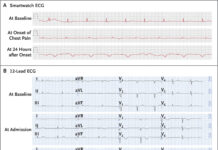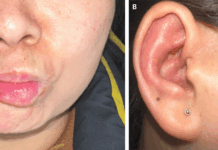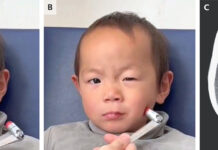Despite being careful, a 21-year-old woman ended up with infected ear cartilage after getting it pierced while she was on her vacations in Thailand!
A 21-year-old woman got her upper ear cartilage pierced while she was enjoying her vacations in Thailand. ربح مال حقيقي She carefully selected a professional piercer for the job. The sanitary conditions were also up to the mark. But guess she was out of luck!
The piercer first swabbed the ear with an unknown solution and then he injected the local anaesthetic solution with a syringe packed in its own packaging. رهان المباريات Since the syringe was in its packing, the patient assumed that the syringe is new and sterile.
At the time of piercing, he inserted a titanium earring.
One week after the ear piercing, the patient resumed swimming in the Gulf of Thailand.
Approximately, 2 weeks after the piercing, and 1 week after the swim, her ear became painful.
She returned to Canada, where she consulted a physician as her ear was red (erythematous) with a purulent discharge. This was 3 weeks after the piercing.
The physician removed her earring and started her on cephalexin 500 mg four times daily for 7 days with an assumption that Staph. Aureus was the most likely culprit pathogen. Before the start of antibiotics, the doctor had collected a swab for culture and sensitivity testing.
Despite being compliant with the antibiotics, the patient’s ear worsened. Now she was experiencing intense discomfort. However, she did not have any fever and the redness of the ear had not worsened.
The doctor reassessed the patient 2 days after the first visit and noticed a serosanguineous discharge but no abscess. Moreover, there was no lymphadenopathy.
The preliminary swab culture report showed gram-negative bacilli, therefore, the doctor added another antibiotic (levofloxacin). Later, after the definitive report, the doctor changed one of her antibiotics according to the sensitivity of the organism. الرهانات
Around 3-4 days later, the patient started to feel better. The pain was improving. Moreover, the erythema had decreased too. However, there was a localised swelling which required incision and drainage.
Despite the drainage, the swelling persisted. The doctor suspected the viability of the organism in the cartilage.
The family physician consulted an ENT specialist and the infectious department. Thereafter, she underwent debridement and an ear splint.
One week later, they removed her splint. The ear had considerably improved. It was no longer red nor had any discharge. The ear healed without any serious deformity.




